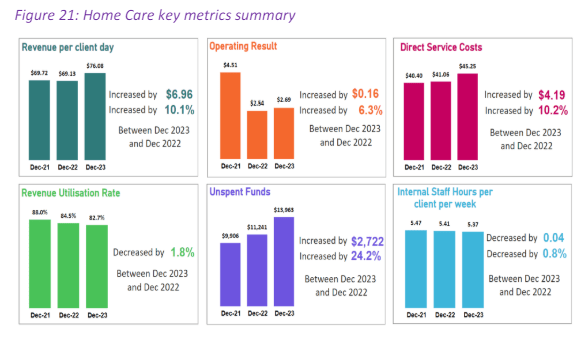Latest StewartBrown results underline need for Government to adopt Taskforce recommendations
Residential aged care operators continued to make significant losses in the delivery of everyday living and accommodation services, StewartBrown's Aged Care Financial Performance Survey for the six months to 31 December 2023 shows. Providers...

Residential aged care operators continued to make significant losses in the delivery of everyday living and accommodation services, the StewartBrown Aged Care Financial Performance Survey for the six months to 31 December 2023 shows. Residential care providers recorded a loss of $5.40 per bed day (pbd) for everyday living (also referred to as indirect care, including catering, cleaning, laundry, utilities, administration) in the six months to December 2023, compared with a loss of $6.36pbd for the previous corresponding period (pcp), the 46-page report states. The accommodation result was a loss of $10.11, compared with a loss of $14.14 in the pcp. However, care operations continued to operate at a surplus. For the six months to December 2022, the direct care result was a profit of $13.26, up from a profit of $4.52 in the pcp. The increasing profitability of care while indirect care and accommodation continue to operate at a loss highlights the importance of the Aged Care Taskforce's recommendations relating to increased consumer contributions. The StewartBrown Aged Care Financial Performance Survey notes that recommendations 10 (daily living costs need to be fully funded with the Basic Daily Fee and a supplement, with residents who can afford to paying some or all of the supplement), 13 (providers retaining a portion of the RAD), and 14 (review the Accommodation Supplement) should help to address these losses, although they noted that some may take several years to be implemented. Other highlights from the Survey for residential care include:
- Agency staffing costs remained high for the December quarter at $17.52pbd, driven by increased RN agency costs, compared with $16.96 the previous quarter. Meeting the 40 RN care minute targets would cost providers an additional $5.75pbd on agency costs based on December 2023 rates, StewartBrown estimated.
- A look at economies of scale showed that operators with 21 and more homes achieved an operating profit of $7.60pdb, compared with a loss of $11.96 for single homes, a loss of $8.72 for 2-6 homes, and a loss of $8.43 for 7-20 homes.
- The report notes the difficulties for regional homes, particularly MMM2 to MMM5, and suggests that "additional block funding may be required in the short/medium term".
- The number of homes using internal catering increased from 68% in 2020-21 to 73% in the December 2023 survey.
- Occupancy for the six months to 31 December 2023 was 92.8%, the highest since December 2020.
- 52% of aged care homes were operating at a loss, compared with 63% in the pcp.
Home Care - unspent funds reach $3.7 billion

StewartBrown noted the home care sector operates with "uncertainty" while still largely unknown reforms are set to come in with the new Support at Home Program due on 1 July 2025. For the six months to December 2023, home care operators recorded a surplus of $2.69 per client per day (pcpd), slightly higher than the $2.54 recorded in the pcp. Unspent funds rose to an average of $13,963 for every home care recipient, making an estimated total of more than $3.7 billion in unspent funds being held by providers and the Government, as revenue utilisation decreased to 82.7% from 84.5% in the pcp.






